The over-title of the present essay is taken from a playful poem by Arrigo Boito and takes us back to the steps of art criticism that proceeds slowly and wisely on new discoveries, even on minor appearances, to illuminate connections and knowledge not infrequently capable of emotion.
For this occasion, it is interesting to start with the “Association of Friends of Correggio,” which acts in the painter’s hometown and has long taken on commitments to study, promote and support Allegri’s research in the international arena. In recent years, in addition to participating in high-profile exhibitions, promoting lectures, correspondences and translations of key texts, the Association has celebrated the fifth centenary of the Madonna di San Francesco in direct concordance with the Gemäldegalerie in Dresden (Silvana editrice notebook edited by Giuseppe Adani, 1515) and the fifth centenary of the “Camera di San Paolo” with a new reading by Renza Bolognesi (Silvana editrice notebook, 2018); collaborated on the exhibition of San Bendetto Po Dal Correggio a Giulio Romano (2020); turned to the acquisition of works of certain value such as the beautiful autograph panel of the Saint Agatha, and ancient copies having a direct part in the historical fortune of the famous Renaissance leader.
The Association’s eyes did not tire of scrutinizing small auctions and adventitious bargains that in some way concerned Correggio (Antonio Allegri, known as Correggio; c. 1489 - 1534), so recently a copper of curious interest glided into the Po Valley town, eponymous with the artist. The visibility of the painting and its whimsical frame, after the first quiet appreciation, began to raise questions and require further investigation, which observation sharpened more and more, so much so that it was decided to involve a genuine primary restorer who could render the full truth about a subject so rare and so finely reproduced. It is in fact the copy of the Madonna of the Basket, an Allegrian masterpiece that Vasari called “bello a maraviglia” whose original is on a panel measuring 34 x 25 cm, now in the National Gallery in London. Of exceptional iconographic choice, it restores to us a moment of the artist’s intimate freedom in his shining years (1525-26) when he meditated on the inexperienced theme of working on the Holy Family during his exiled stay in Egypt.
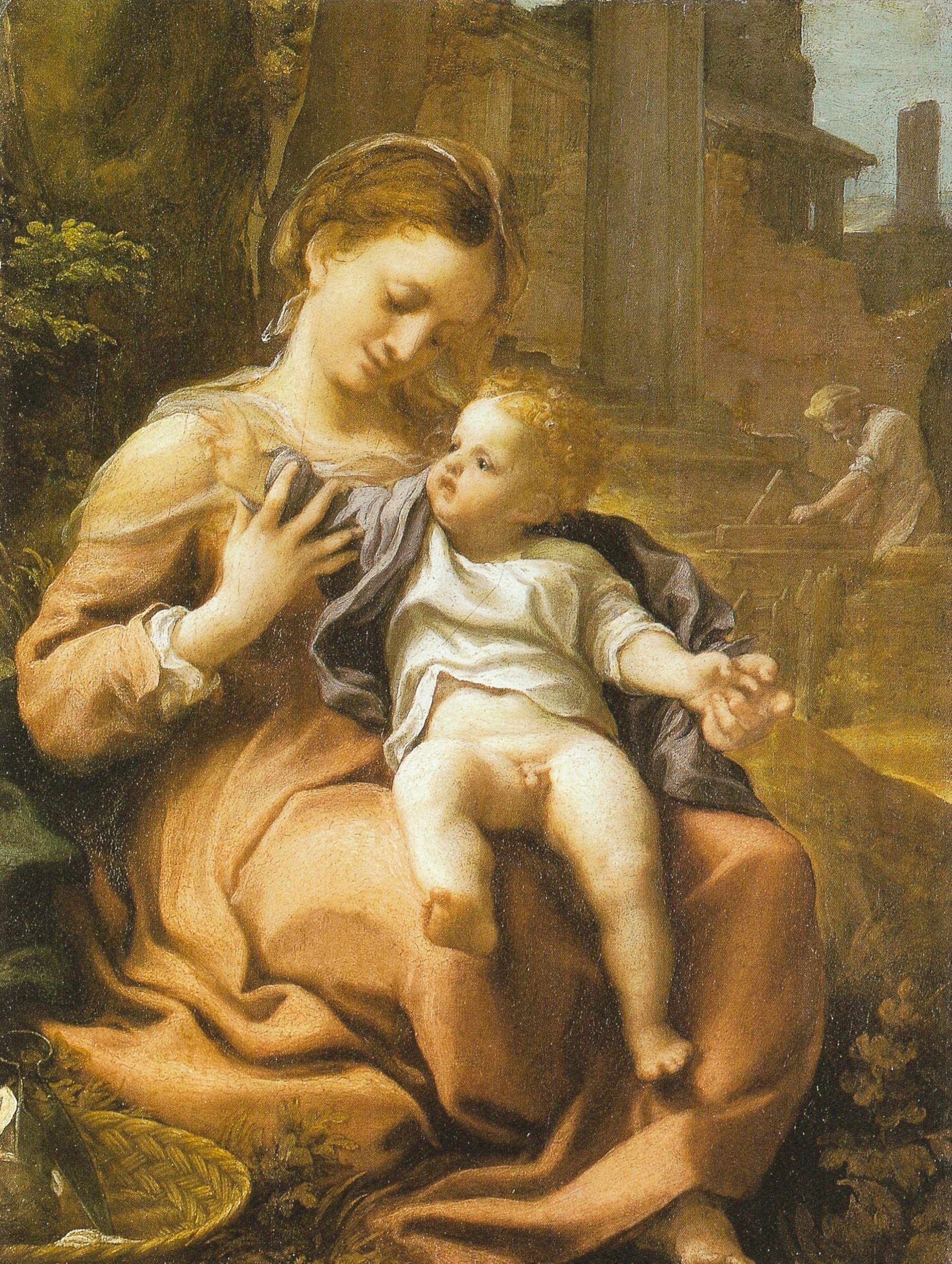 |
| Antonio Allegri known as Correggio, Madonna of the Basket (oil on panel, 34 x 25 cm; London, National Gallery) |
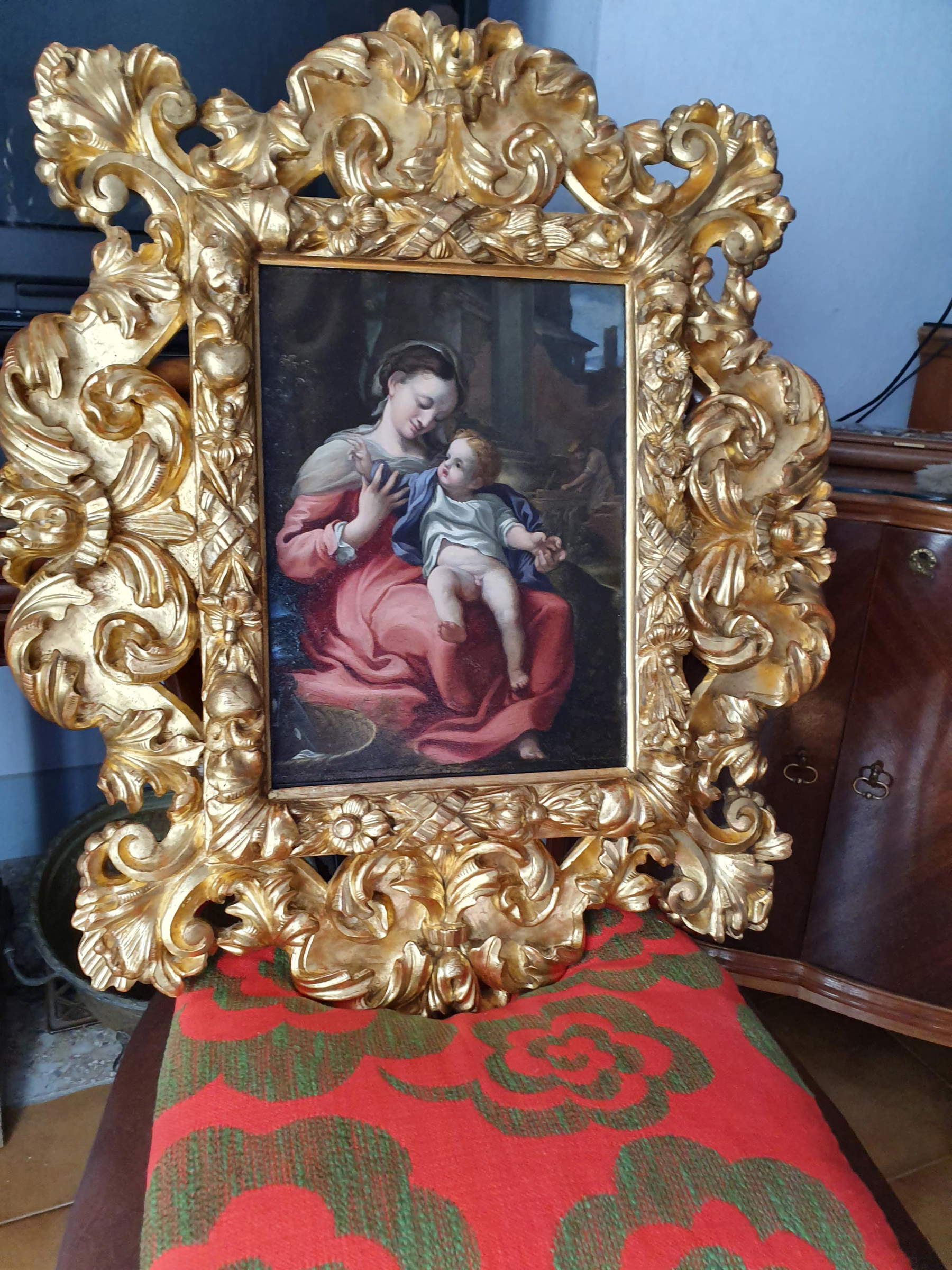 |
| Girolamo Sellari, called Girolamo da Carpi, Copy of the Madonna of the Basket (oil on copper, 34 x 27 cm; Correggio, private collection). Enthusiastically recalled by Vasari. |
It is necessary to pause for a few moments to consider how some of Correggio’s small religious panels immediately enjoyed wide notoriety and a large number of copies, perhaps unparalleled: a lively approval not only among the people but intense among the painters, who understood how Correggio’s language, apparently easy, contained instead an extraordinary height of style and brand new communication skills. Our Lady of the Basket is one of these: Mary’s work basket, placed in the foreground, and St. Joseph’s striving in the background compose a sweet family atmosphere that makes the central scene as spontaneous as possible despite the difficult and “contemptuous” posture. We see the Mother stretching out the arms of the Child, a sign of the prelude to the cross, to try on the gown she has just made, and the infant Jesus almost realizing the purpose of his incarnation opens to bless.
Note how on the sacral bodies, a double light acts, the physical one from above and another that emanates from within in some places: this sensitivity is to be read with extreme care. Other lights then appear in the painting arranged between the planes; the whole, with the complex of the architecture toward the infinitude of the landscape and the loving embrace of the plants, makes this Correggesque moment moving and unforgettable. And the sole of the Child’s foot, together with his nudity, adds a signature of the Allegrian heart, and gives a loving thrill that to every female soul tenderizes the lip.
Let us then come to the copy on copper that measures 34 x 27 cm and that so attracts us today. We know that Correggio’s original had complicated and lacunar events but we are certain that one of the first owners, if not the first, was the Parma knight Francesco Baiardo, also known as Parmigianino’s major patron. And here we enter the earliest authentic record we find in Vasari’s opus magnum, specifically in the paired lives of Benvenuto Garofalo and Girolamo da Carpi (Giuntina edition of 1568). Girolamo da Ferrara, known as “da Carpi” because of his father’s origins (Ferrara 1501 -1556) became a friend of Giorgio Vasari and in 1550 in Rome communicated to him many things about his eventful existence: among them his very vivid enthusiasm for Correggio’s works, some of which he copied: those of the “heads made in paradise.” Let us leave the word directly to Vasari: “from one therefore that Cavalier Boiardo has in Parma, beautiful to marvel, by the hand of Correggio, in which Our Lady puts a shirt on Christ as a child, Girolamo portrayed one to that one so similar that it seems to be truly done.....so well and with such diligence that one cannot see minio more subtly worked et altri infiniti lavorati con molta diligenza.” That “che pare desso veramente” is a testimony of Vasari himself who therefore must have compared de visu the result of Girolamo’s effort.
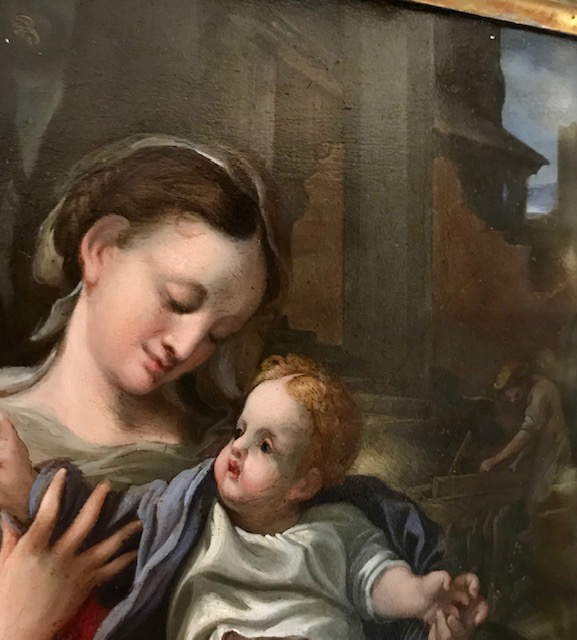 |
| Girolamo da Carpi, Copy from Correggio, detail |
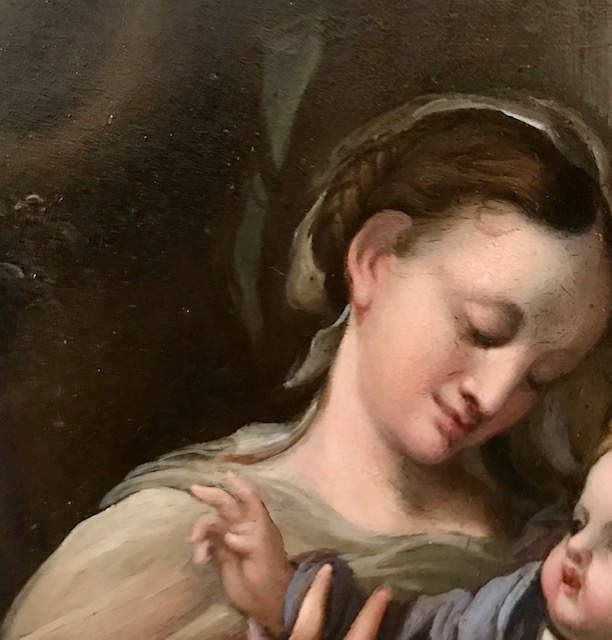 |
| Girolamo da Carpi, Copy from Correggio, detail |
 |
| Girolamo da Carpi, Copy from Correggio, detail |
The relationships that the Friends and scholars of Correggio had with the Vatican Museums on the occasion of the authentic recognition of Allegri’s Redeemer in Glory (2008-2011) yielded two results of great importance: one was the new and in-depth investigation of Correggio’s execution technique, which highlighted the method and procedure of the exceptional author; the other was the friendship with Master Restorer Claudio Rossi De Gasperis (born in Vatican City to an ancient family of high papal service), who has continued to take a growing interest in the unique preparations and chromatic techniques of the Emilian genius. Hence the decision to ask the great Claudio, now in free retirement, for an examination of the acquired copper. With his acceptance, a scientific-artistic falling in love was rekindled in him that clutched together the poetry of Correggio and the infinite diligence of Girolamo.
In a few months of windings, painstaking trials, intancible fixations, instrumental aids, delicate interventions and comparisons, Rossi De Gasperis restored life and brilliance, right down to the pictorial recesses, to the “new” Madonna of the basket, which he himself described as executed by the hand of a true master. A small fall of color allowed the discovery, truly surprising, of a pictorial execution directly on copper, without preparation. The grazing examination conducted in several parts revealed the carriage of the contours, marked by a very light etching obtained with acid, deriving this from the etching technique: contours and yet not always respected during the application of color. These two factors offer us the certainty of a mastery of craft and a restrained measure of freedom that are remarkable gifts on the part of the copyist-non-copist: Girolamo da Carpi was indeed an excellent painter.
 |
| The frame during restoration. The bole gilding emerges. |
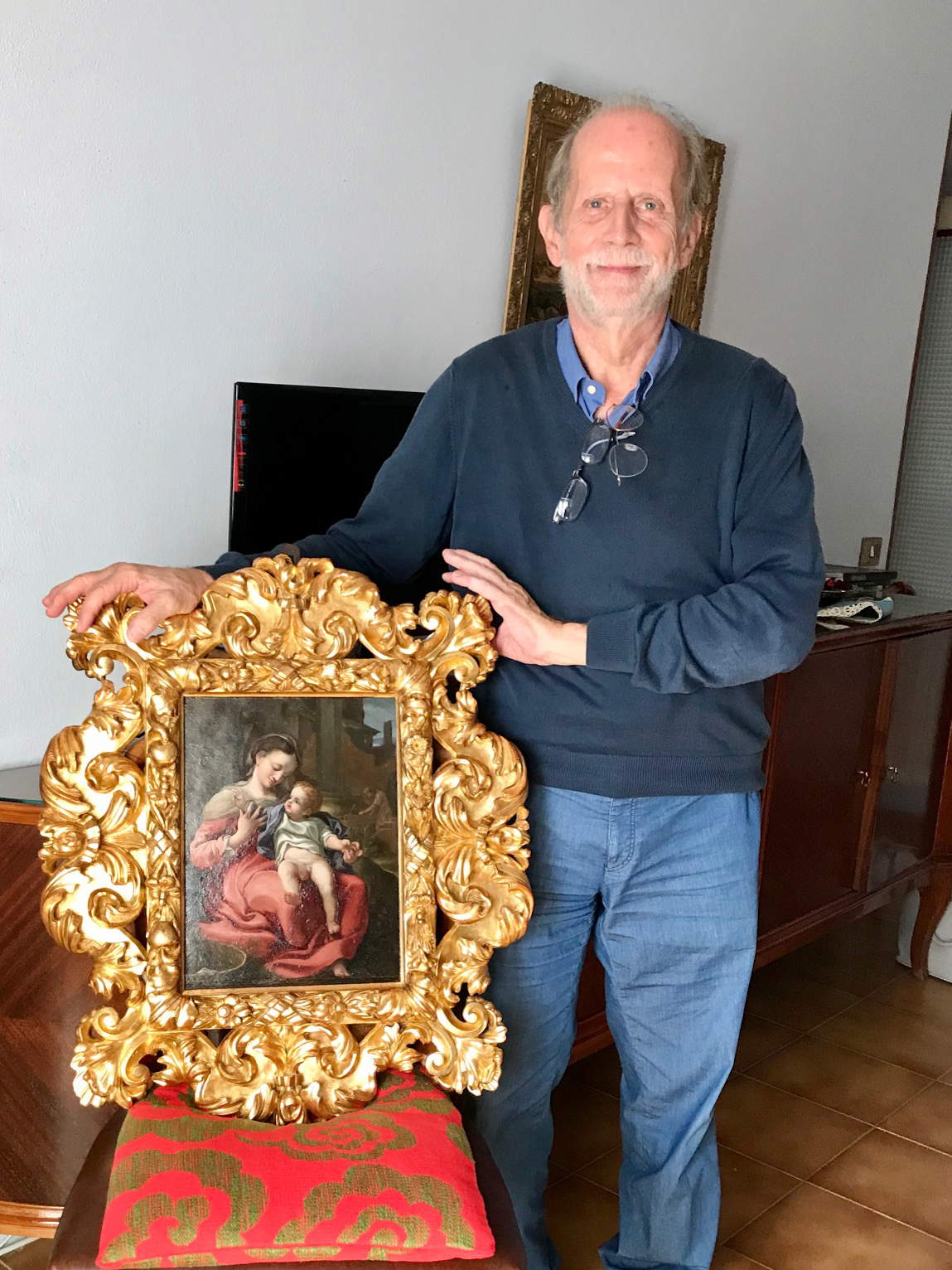 |
| Claudio Rossi De Gasperis with his magnificent achievement (2020). |
The Restoration Report is comprehensive, analytical, and precisely illustrated, also ranging over the technical phenomena of sixteenth-century painting. An enjoyment that is accompanied by all the emotions found in the careful and loving prospecting of the albeit small subject. The Restorer writes: “... an unexpected and precious chromatic surface of the highest quality has increasingly emerged [...] the singular, splendid and diaphanous complexions found, created by unprecedented pink pigments, and the particular luminous whites, blues and precious red lacquers used for Mary’s dress lead one to hypothesize that only the skill, sensitivity and high professionalism of a great master could have created them [ ] the work is painted through rapid brushstrokes, now extraordinarily fluid and transparent, now dense and full-bodied, given without any fear.” The conclusion, as we said, excludes the traditional copyist and points toward a sure artistic distinctiveness. To Jerome’s boast.
But the international Claudius also turned his attention as an ancient wizard of Vatican treasures to the frame. An enraptured possessor, probably in the seventeenth century, endowed the copper with a beautifully carved wooden frame to superbly crown the subject. It appeared beautifully burnished and burnished, but certain reflections betrayed a symptom that needed further investigation. With a multiple procedure, well aware of the ancient bad “maintenance” based on petroleum and then on animal glue given hot, the restorer conducted a very patient and controlled enzymatic cleaning that brought to light again the extraordinary splendid gilding of pure gold, richly spread over every part, even hidden, of the opulent frame that now shines with enchanting nobility.
It only remains for us to record the confirmation “in corpore” of Vasari’s happy news, and to declare the painting published here as a sure work by Girolamo da Carpi.
Warning: the translation into English of the original Italian article was created using automatic tools. We undertake to review all articles, but we do not guarantee the total absence of inaccuracies in the translation due to the program. You can find the original by clicking on the ITA button. If you find any mistake,please contact us.